Diatomaceous earth (DE) effectively kills mosquitoes through microscopic sharp particles that damage their exoskeletons. You’ll get best results by creating thin rings around breeding sites, treating moist soil areas, applying a 2-inch band where water collects, combining DE with essential oils, and reapplying after rain. Wear protective gear during application, use dusters for even distribution, and maintain consistent applications throughout mosquito season. This natural approach works best when you develop a thorough strategy targeting their entire life cycle.
Understanding How Diatomaceous Earth Affects Mosquito Life Cycles
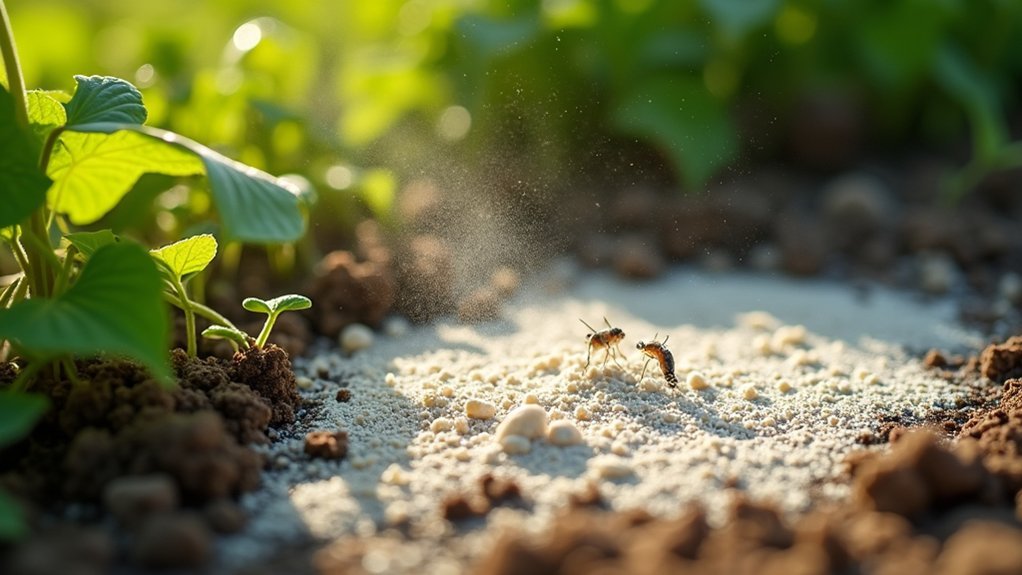
While many natural mosquito control methods claim effectiveness, diatomaceous earth (DE) offers a distinctive mechanical approach to elimination.
When applying diatomaceous earth to mosquito-prone areas, you’re utilizing microscopic sharp particles that damage their protective exoskeletons, causing dehydration upon contact.
Unlike chemical solutions, this natural pest control works primarily on adult mosquitoes in dry environments rather than larvae in standing water.
DE’s mechanical action targets adult mosquitoes in dry areas, leaving aquatic larvae unaffected by this natural alternative to chemicals.
You’ll notice DE doesn’t immediately disrupt breeding cycles, as mosquitoes often rest on leaf undersides where powder can’t reach.
For thorough mosquito control, target areas where adults congregate and reapply after rainfall.
DE works as a strategic long-term solution rather than a quick fix, gradually reducing populations over time when consistently applied in your pest management routine.
Creating Dry Barriers Around Standing Water Sources
Create an effective perimeter by spreading a thin ring of diatomaceous earth around standing water sources where mosquitoes gather to breed.
You’ll need to refresh these barriers after rainfall or watering, as moisture reduces their effectiveness against larvae and adult mosquitoes.
For best results, apply the powder in a continuous 2-inch band around birdbaths, puddles, and other moisture-prone areas where mosquitoes might lay their eggs.
Perimeter Application Techniques
Strategic placement of diatomaceous earth around water sources creates an effective defense against mosquito breeding.
Apply a 2-3 foot wide barrier surrounding birdbaths, ponds, and damp soil areas to deter mosquitoes before they can establish breeding grounds.
For effective mosquito prevention, use a duster with a nozzle to distribute a thin, even layer of diatomaceous earth around standing water perimeters.
Focus your application on shaded, moisture-rich areas where mosquitoes typically gather.
Always apply to dry surfaces and maintain the barrier by reapplying after rainfall.
During peak mosquito season, inspect your perimeter applications every few weeks and refresh as needed.
This consistent maintenance guarantees your diatomaceous earth barrier remains effective, considerably reducing mosquito populations around your property without harsh chemicals.
Refresh After Rain
Rain presents a significant challenge to diatomaceous earth applications, washing away your carefully placed barriers and diminishing their effectiveness against mosquitoes.
After rainfall, you’ll need to reapply diatomaceous earth to maintain its protective qualities and continue controlling mosquito populations.
Focus on spreading a light layer around water-prone areas like birdbaths and puddles to disrupt mosquito breeding cycles.
The desiccating properties of diatomaceous earth dehydrate larvae when applied to damp soil, preventing them from developing into adults.
Pay special attention to shaded spots, which retain moisture longer and create ideal mosquito breeding grounds.
For maximum effectiveness, apply diatomaceous earth consistently, especially after precipitation.
This ongoing maintenance creates dry barriers that gradually reduce mosquito populations by targeting their reproduction sites rather than just adult insects.
Treating Soil Areas Where Mosquito Larvae Develop
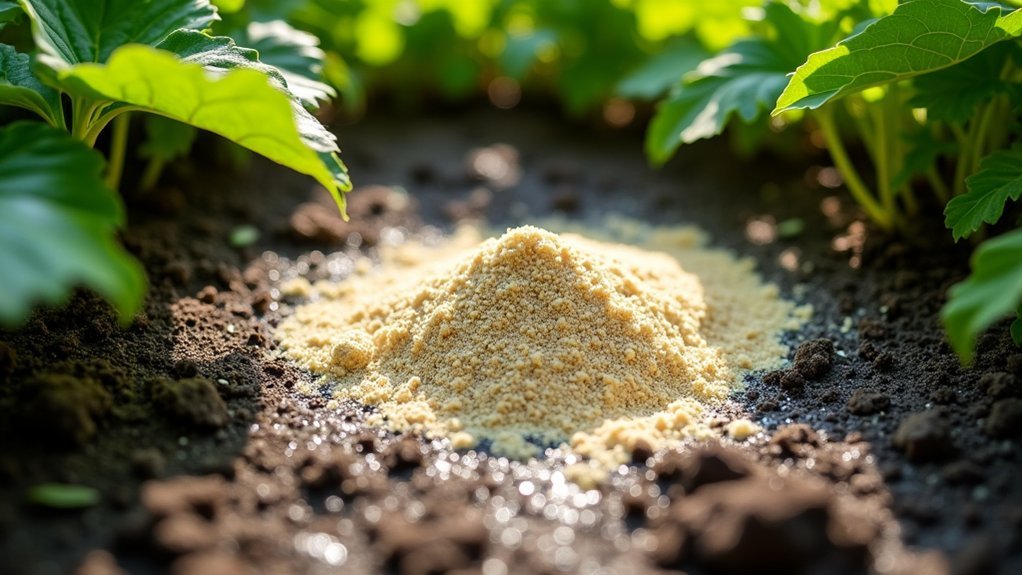
Four key soil locations require diatomaceous earth treatment to effectively combat mosquito larvae.
First, apply DE to moist soil areas where standing water commonly accumulates, as these serve as prime breeding grounds.
Second, target damp soil around birdbaths where mosquitoes frequently lay eggs.
Third, treat ditches that retain moisture after rainfall, creating perfect larval habitats.
When implementing this pest control method, make sure you spread the Diatomaceous Earth evenly across these areas to create an effective barrier that dehydrates larvae upon contact.
Remember to reapply after heavy rain since moisture washes away the DE, reducing its effectiveness.
While this approach works well to treat soil for larvae, combine it with other prevention methods for thorough mosquito management throughout your property.
Strategic Application Techniques For Outdoor Living Spaces
The key to effective mosquito prevention in outdoor living spaces lies in strategic diatomaceous earth application. Focus on areas where water naturally collects around your patio, deck, and recreational spaces.
Apply DE around birdbaths, pool edges, and decorative ponds using a duster with a precision nozzle for even distribution.
Target crevices, shaded corners, and damp soil near outdoor furniture where mosquitoes rest during hot daylight hours.
After outdoor gatherings, dust the perimeter of your living space to create a protective barrier.
Remember to reapply after rainfall to maintain effectiveness, as moisture diminishes DE’s insecticidal properties.
Position your applications away from high-traffic areas to prevent respiratory irritation while still maximizing mosquito contact.
This balanced approach guarantees your outdoor spaces remain comfortable without compromising on pest control effectiveness.
Combining Diatomaceous Earth With Other Natural Repellents
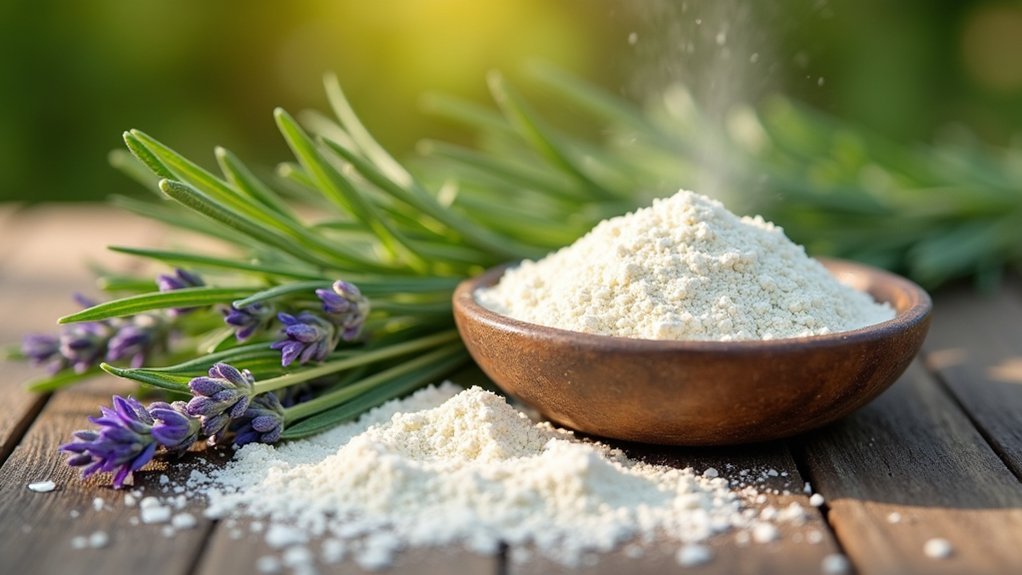
Maximizing your mosquito defense requires a multi-layered approach that combines diatomaceous earth with complementary natural repellents.
Try creating a potent spray by mixing diatomaceous earth with water and essential oils like citronella and lemon eucalyptus—this dual-action solution both treats surfaces and disperses insect-repelling scents.
Sprinkle diatomaceous earth in areas where you’ve applied natural repellents to dehydrate any mosquitoes that land despite the initial deterrent.
For enhanced effectiveness, pair DE with strong-smelling garlic and vinegar sprays, which repel mosquitoes while the diatomaceous earth eliminates those that ignore the odor barrier.
Consider establishing mosquito-repelling plants such as marigolds and catnip around your property, then dust the surrounding soil with diatomaceous earth to create a thorough defense system that targets mosquitoes through both physical and olfactory deterrents.
Protecting Gardens And Plant Areas From Mosquito Breeding
Gardens and plant areas present unique challenges for mosquito prevention, as they naturally combine the moisture and shelter that mosquitoes need to breed. Diatomaceous earth creates an effective barrier against mosquito larvae when applied around plant bases and in soil.
| Location | Application Method |
|---|---|
| Plant bases | Create a protective ring of diatomaceous earth |
| Flower pots | Sprinkle on soil surface and around drainage holes |
| Birdbaths | Apply around edges and nearby soil |
| Shaded areas | Focus on moisture-prone spots where larvae develop |
For lasting protection, reapply diatomaceous earth after rain or watering. Combine this approach with natural repellents like citronella and marigolds to create a thorough defense against garden pests. Regularly inspect shaded, moist areas where mosquitoes commonly breed, ensuring these potential hotspots receive careful treatment.
Indoor Defense Methods Using Food-Grade Diatomaceous Earth
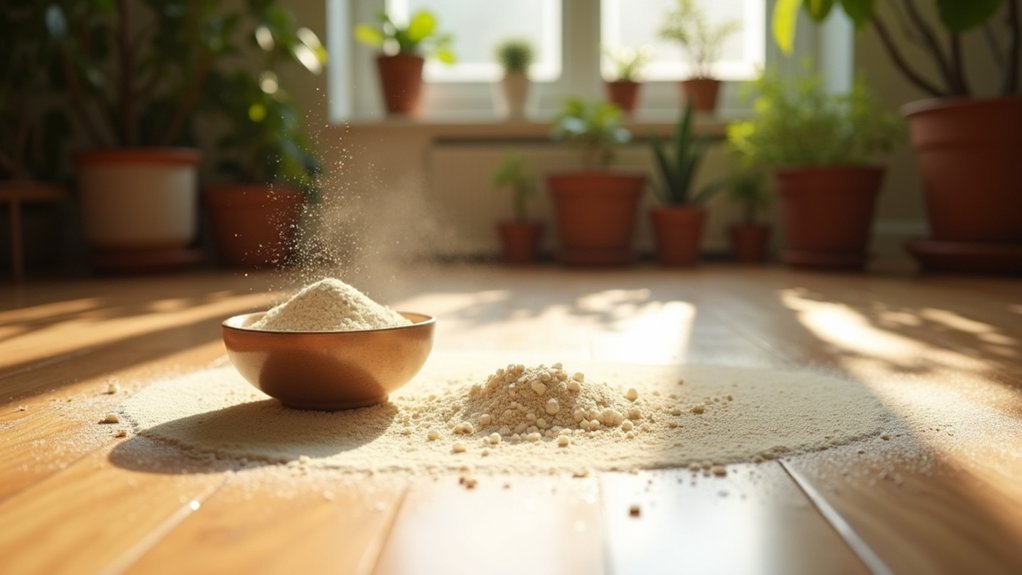
While gardens serve as prime breeding grounds for mosquitoes outdoors, your home’s interior can also harbor these pests without proper protection. Food-grade diatomaceous earth offers an effective indoor defense strategy against these unwelcome visitors.
Create protective barriers by sprinkling diatomaceous earth along windowsills and doorways where mosquitoes typically enter. For thorough mosquito prevention, use a duster with a nozzle to apply thin, even layers in cracks and hidden spaces where they might lurk. This natural substance dehydrates and kills mosquitoes upon contact.
Apply in dry conditions and remember to reapply after cleaning or rainfall to maintain effectiveness. While safe for homes with children and pets, wear a mask during application to avoid inhalation.
Regular inspection and reviving of your diatomaceous earth barriers guarantees continuous protection against mosquito infestations.
Application Tools And Methods For Maximum Effectiveness
The right tools and methods greatly multiply diatomaceous earth’s effectiveness against mosquitoes. For ideal results, use a duster with a nozzle attachment to apply diatomaceous earth evenly in mosquito breeding sites, especially in damp soil and near standing water.
Always apply in dry conditions to preserve its desiccating properties that dehydrate mosquitoes on contact. Focus your application in shaded, moisture-rich areas where mosquitoes breed and rest.
After rainfall or watering, don’t forget to reapply, as moisture diminishes its effectiveness.
For precise application, a fine mist spray bottle helps you dust surfaces lightly while avoiding high-traffic areas that might cause respiratory irritation.
These application tools guarantee maximum effectiveness by strategically targeting mosquitoes while minimizing potential discomfort for your household.
Seasonal Application Schedules For Year-Round Protection
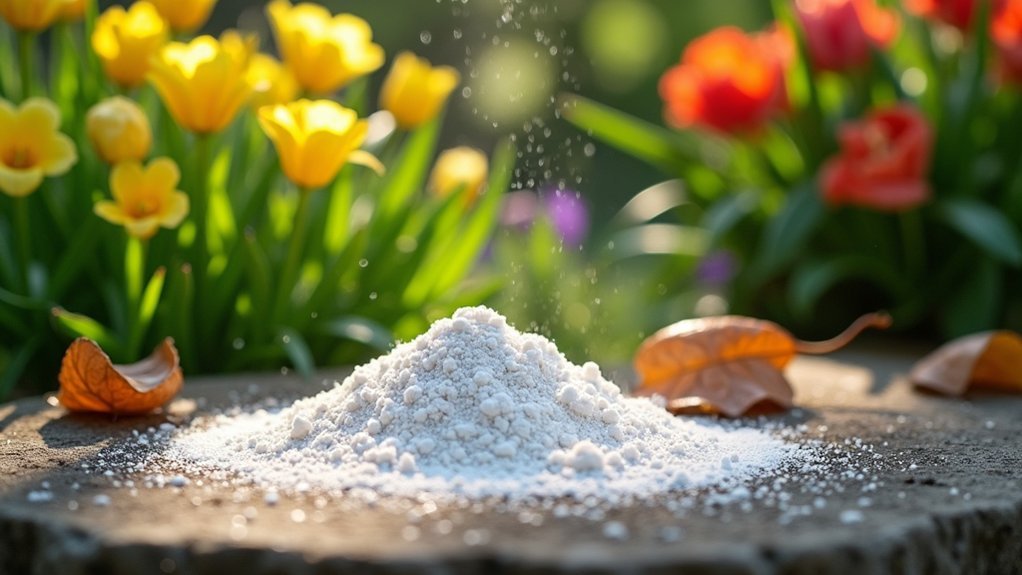
Developing a strategic seasonal schedule maximizes diatomaceous earth’s effectiveness against mosquitoes throughout the entire year.
Begin your mosquito prevention routine in early spring by targeting breeding grounds before mosquito populations explode. This proactive approach disrupts their life cycle before it begins.
Spring is mosquito warfare season: attack breeding sites early to prevent population explosions before they begin.
During peak mosquito season (late spring to early fall), reapply diatomaceous earth every few weeks, especially after rainfall which can wash away previous applications.
Focus on moisture-prone areas where mosquitoes breed.
By late summer, concentrate on gutters and shaded spots where moisture lingers as mosquitoes prepare for seasonal changes.
For thorough protection, integrate diatomaceous earth with other natural repellents in your pest management strategy.
This systematic approach guarantees you’re maintaining consistent protection while adapting to seasonal mosquito behavior patterns and environmental conditions.
Safe Handling Practices When Using Diatomaceous Earth Outdoors
Safe handling of diatomaceous earth requires five essential precautions to protect your health while maximizing its mosquito-fighting benefits.
When handling diatomaceous earth, always wear a protective mask or respirator to prevent inhaling the fine dust particles that can irritate your respiratory system.
Apply diatomaceous earth on calm, dry days to avoid wind dispersing the powder into the air. It’s safe for use around your home, but keep in mind that gloves are necessary to prevent skin dryness and irritation from prolonged contact.
Keep children and pets away during application to avoid accidental inhalation or ingestion.
After use, store your diatomaceous earth in a cool, dry location to maintain its effectiveness and prevent clumping.
These precautions guarantee you’ll remain protected while effectively controlling mosquitoes.
Frequently Asked Questions
What Not to Mix With Diatomaceous Earth?
Don’t mix diatomaceous earth with water, oil-based substances, chemical pesticides, moisture-retaining additives like fertilizers, or high-moisture insect repellents. These combinations reduce its effectiveness by compromising its desiccant and abrasive properties.
Why Do Exterminators Not Use Diatomaceous Earth?
Exterminators don’t use diatomaceous earth because it doesn’t stick to mosquito landing surfaces, takes too long to work, fails to kill larvae in water, and isn’t as effective as chemical insecticides for quick results.
What Is the Best Way to Apply Diatomaceous Earth?
Use a duster with a nozzle for even distribution. You’ll want to apply it during dry conditions, targeting soil and surfaces near breeding sites. Don’t forget to reapply after rain for continued effectiveness.
Can You Overuse Diatomaceous Earth?
Yes, you can overuse diatomaceous earth. Excessive application won’t improve pest control and may cause respiratory irritation, skin dryness, and harm beneficial insects. It’s best to apply lightly in targeted areas only.
In Summary
By incorporating these diatomaceous earth methods into your mosquito prevention strategy, you’ll create a powerful defense against these persistent pests. Remember, consistency is key—you’ll need to reapply after rain and maintain your treatments throughout mosquito season. With proper application and safety precautions, you’re now equipped to protect your family and enjoy your outdoor spaces without the constant buzzing and biting of mosquitoes.

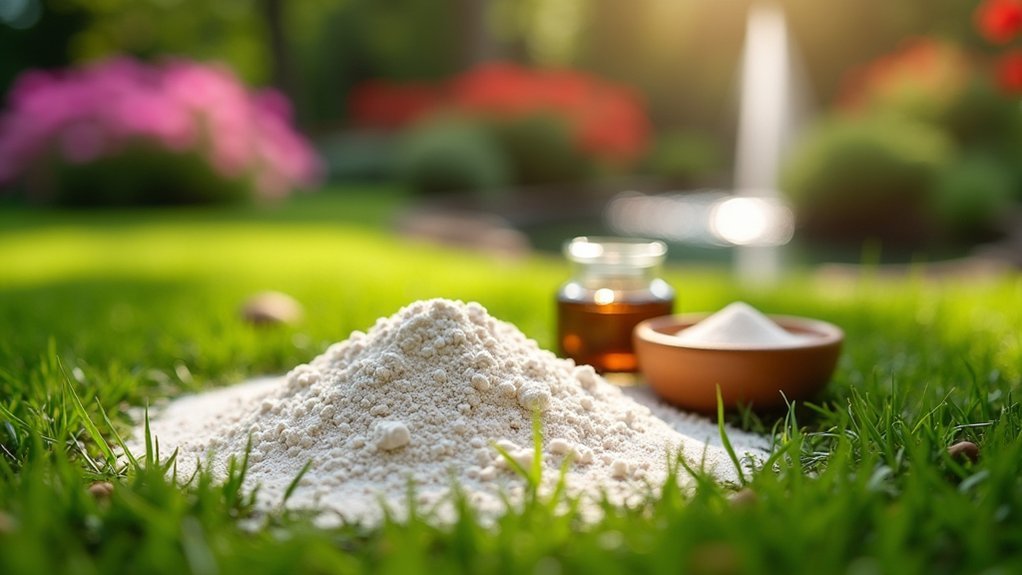



Leave a Reply